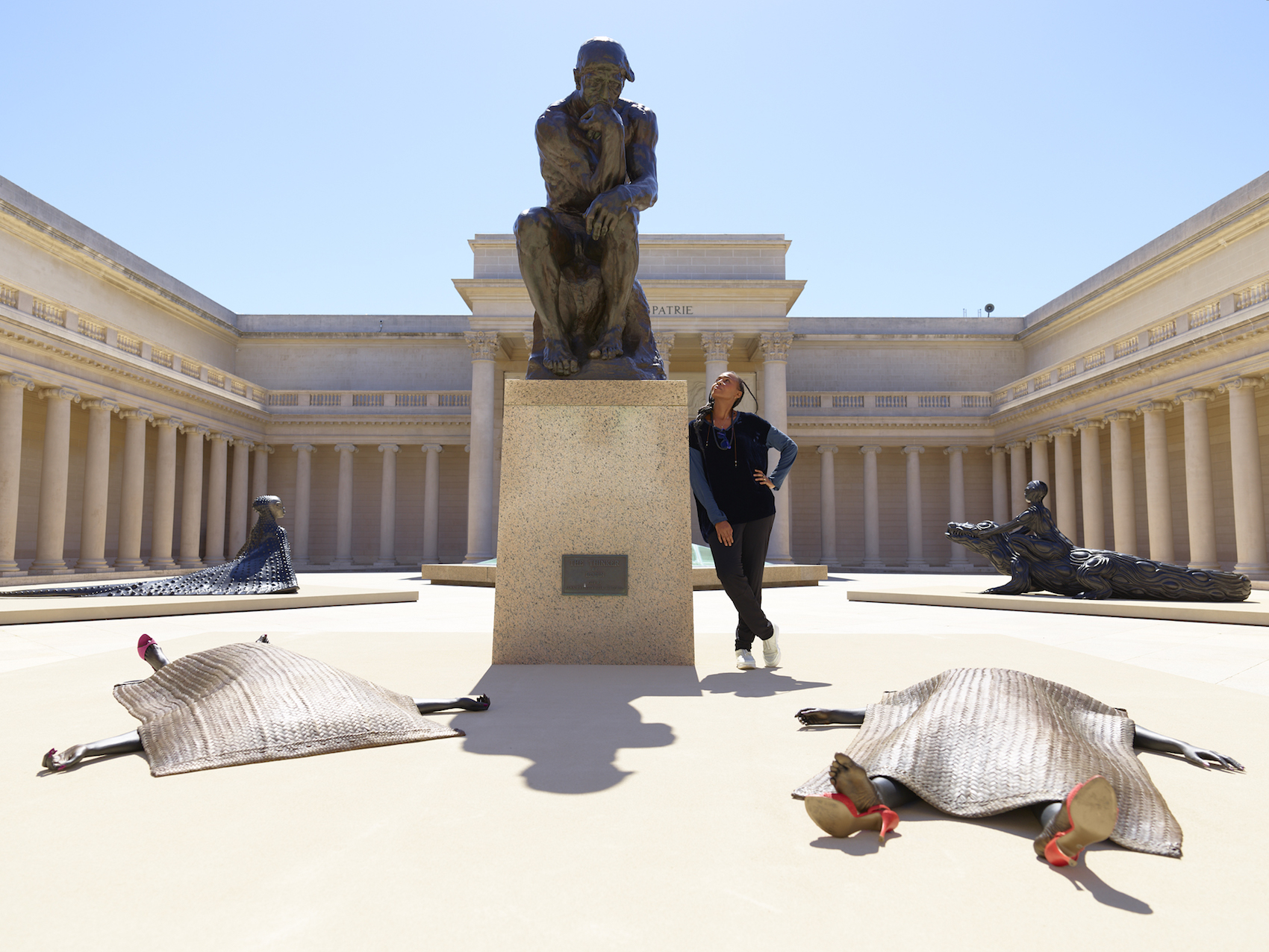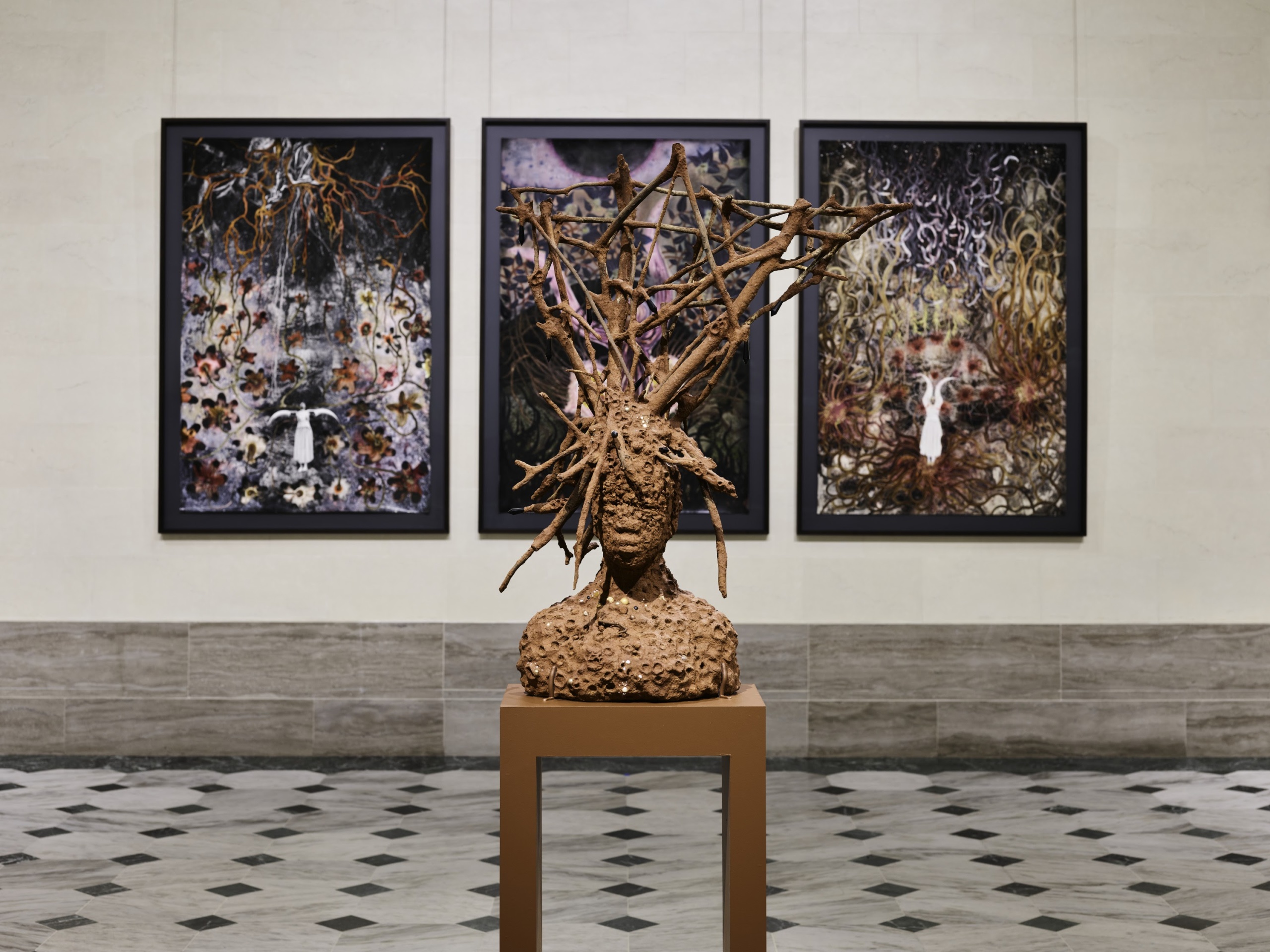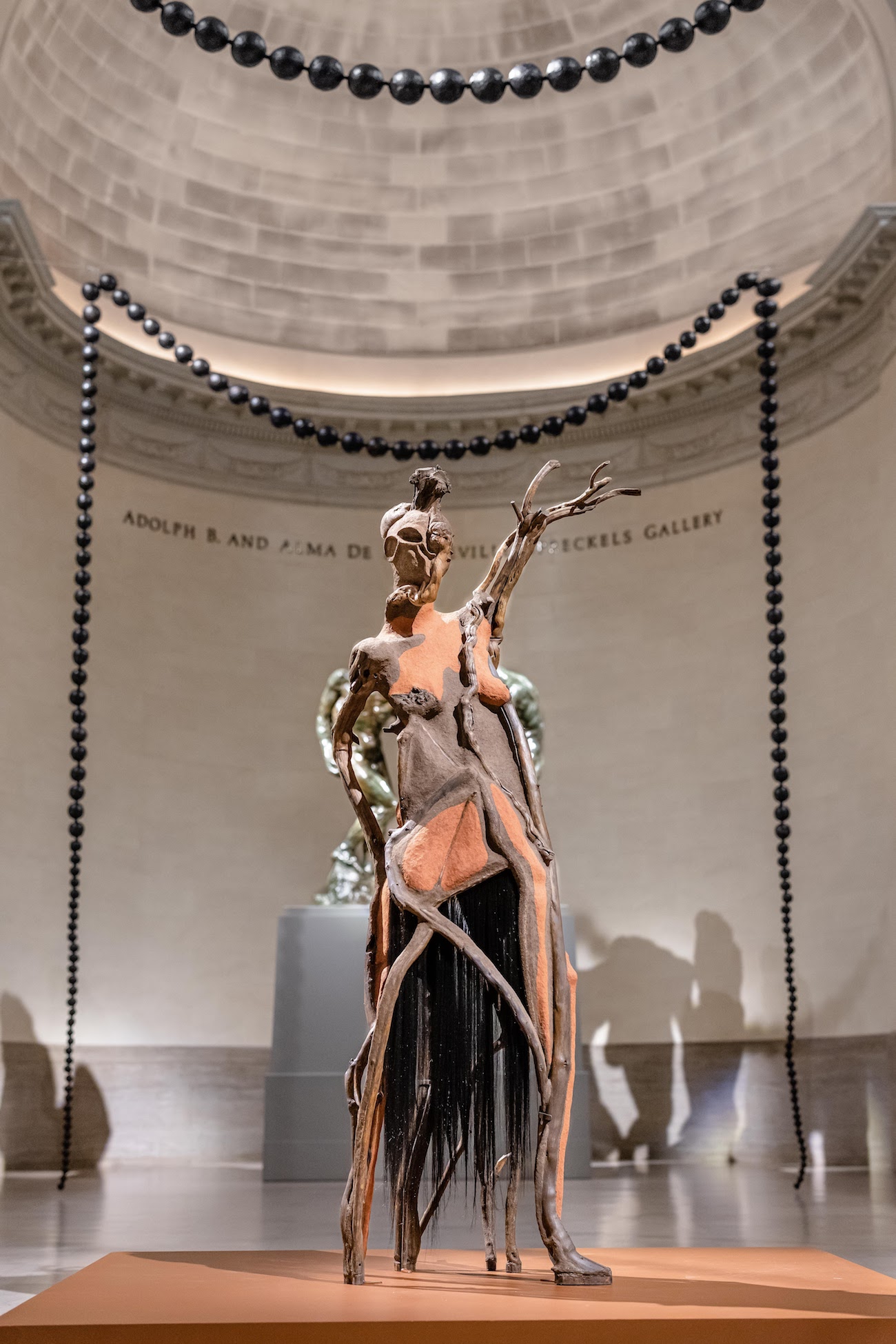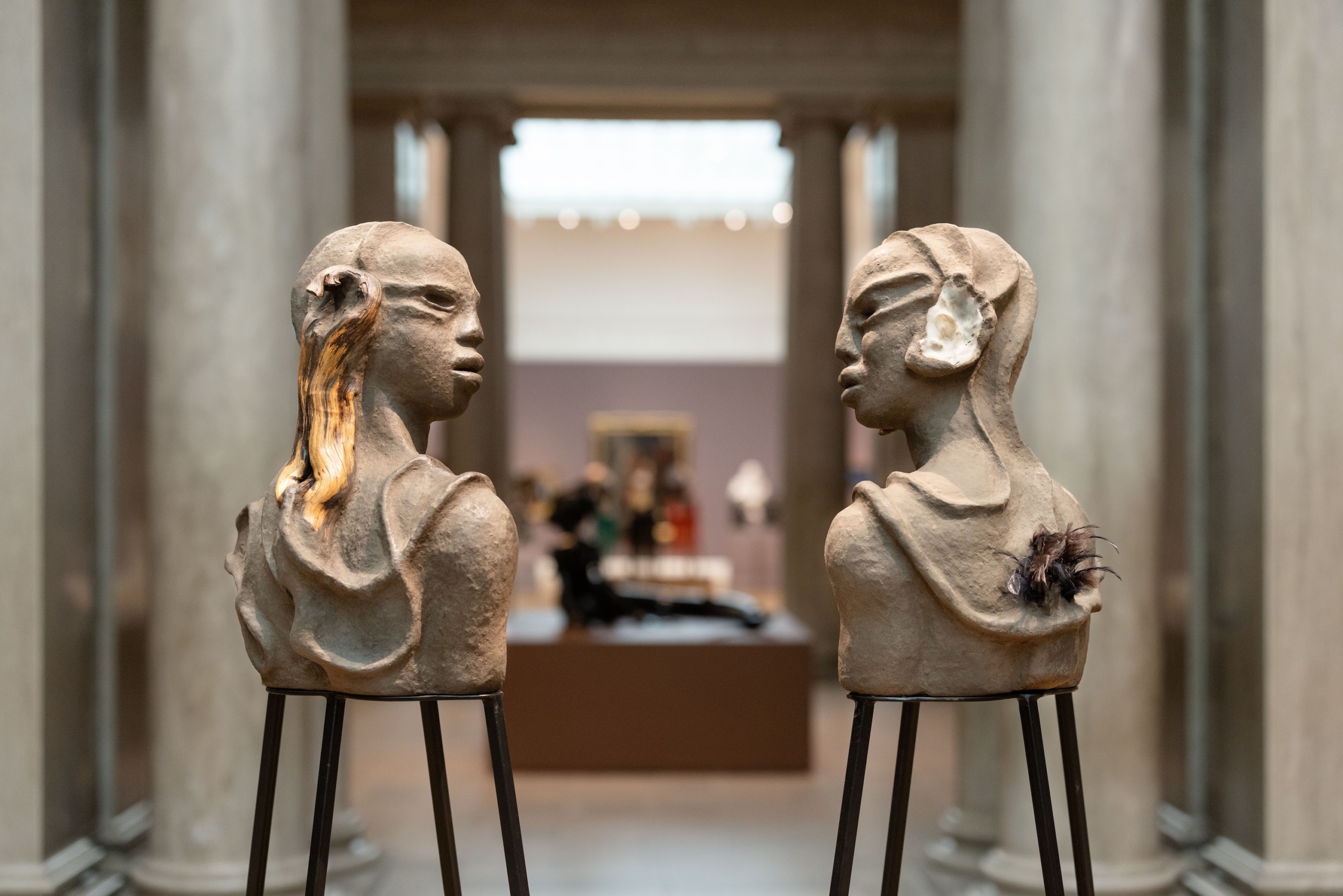
“I Am Speaking, Are You Listening?” is set within the outdoor Court of Honor, most notably home to Auguste Rodin’s bronze cast of The Thinker (1880), and the inner galleries, which house a multitude of European historical artifacts from antiquity to impressionism. Monuments and figures from old mythologies such as Dante’s Inferno, represented in Rodin’s The Gates of Hell (1917), are engaged in a conversation with Mutu’s new hybrid mythologies of Afrofuturism, posthumanism and feminism. They are visually represented and brought to life by way of busts, full-body sculptures, films and collages which challenge the received art-historical narrative. Mutu’s sensibilities not only live up to, but elevate the grandeur of the Legion of Honor. Her personal history, being from both Nairobi and New York, allows for a meeting of materiality and historical ideologies instead of separating them. The museum’s audience is challenged to answer her question: “I am speaking, are you listening?” Her explorations of materials from her native Kenya, combined with some traditional sensibilities due to her Western art education, have birthed these hybrid female figures who are all at once deities, omens, machines, flora and fauna. The works themselves stand alone as hypnotizing, visually pleasing and prompting introspection, but they are activated in a certain context of all art explorations that have come before them, by breaking down binaries and reminding us that we as humans have continued to embark on our own demise, but we can try and change it with the help of a new approach that Wangechi Mutu has presented.
Interview One: Wangechi Mutu
Storm Ascher: Your work is known to question reality. The title of your show alone is such a strong question. I love when the concept of a show demands an answer. To whom are you asking this question, “I Am Speaking, Are You Listening?” Who is speaking and who are they trying to be heard by?
Wangechi Mutu: I honestly believe all art questions reality; some better than others and some more intentionally than others. I think anyone who is attentive to the state of the world, anyone who cares about human life, anyone who is infuriated by injustice and tired of the perpetual violence targeted against the disempowered and anyone who is listening, is asking if anyone in power is paying attention. The question is asked of you; the question is asked to the reader, the audience, it’s asked of myself as I work, as I sit with my family, as I collect my thoughts… I hear the question asked of me from my artwork, from within, from my conscience.
SA: What was the process like of working with Claudia Schmuckli for this exhibition?
WM: It was a very rewarding, but sometimes nerve-racking process. Claudia was extremely keen and always committed from the get-go. She and I were very attentive and communicated a lot. Even in the worst times during the pandemic, when it was most difficult, we kept the conversation, the planning and the ideas flowing. So, it was exhilarating throughout, a real group engagement. I’m so glad that the art and the ideas are doing their work, and that the public gets to see both inside and outside of the Museum.
SA: In your work, I’ve found that the tropes of femininity and beauty are both elevated and turned on their head at the same time. What makes this possible?
WM: I’m not sure how it’s not possible, only that I think that is exactly how it works. “Tropes” of femininity can cause you to seem elevated, and tropes of femininity can also make one undervalued.
SA: What is the significance of the use of birds and feathers in your work?
WM: I love birds and I’m so inspired by their plumage and their songs. But I also enjoy how birds themselves love the way they sing and that they love how they dress. They are totally aware of their own beauty.
SA: You’ve stated in the past that you see water, specifically the ocean, as a canvas. Why is that?
WM: I think the Sea is the portal from which all living beings first arrived. It is the book from which we were all written; the origination story prior to all others.
SA: Are you employing these mythological beings as guardians of the Black experience and our histories? Are they deities? Omens? I can imagine them as protectors our ancestors could have engaged with while being unwillingly transported across the sea.
WM: Yes, I am. Yes, they are.
SA: Why do you believe it is important to create mythological worlds?
WM: I love stories and I think we all believe in stories as a source of inspiration and empowerment.

SA: Are you performing as yourself in your work, or are you also taking on a desired persona?
WM: I’m making a heartfelt prayer, through motion and calling upon the Earth. I’m acting out a hope that the Earth will pardon us all for our foolishness, our lack of wisdom and our cruelty.
SA: How do you see your work in the context of the collection at Legion of Honor?
WM: All of us humans come from people who originated in Africa, that’s where all of this began.
Interview Two: Claudia Schmuckli
SA: Having been at the Blaffer, Guggenheim and MoMA previously, what is different about your experience and your role in San Francisco?
Claudia Schmuckli: When I came to the Fine Arts Museums they didn’t have a dedicated department for contemporary art and programming, and so, having worked at major modern art museums and, you know, a contemporary kunsthalle before, it was really an interesting challenge for me to think about how to curate and how to think about a contemporary program in the context of what is generally referred to as an encyclopedic museum, although that’s of course an imperfect term.
So from the outset I took a very contextual approach. I felt it was important to think about the program in relationship to both sites, since there are two museums, which are radically different in terms of their location within the city, their architecture, as well as the collections that they house. And to think strategically about how to insert contemporary voices into these different contexts. So thinking about it in relationship to the buildings and collections and also the surroundings, in particular Golden Gate Park. When you start from nothing you have to embrace a start-up mentality of sorts, to envision what you could accomplish within a setting like that. It’s not that I walked in and there was a huge collection of contemporary art or an established mode of working with living artists. We had to create the infrastructure for that, which was initially quite challenging. And also build trust and support for these kinds of interventions and exhibitions to take place.
SA: What sensibilities do you look out for when considering an artist for a show of this scale?
CS: It has to be an artist with a certain gravitas to take on the Legion of Honor, because it’s an endeavor. I mean, you have a lot of aspects to deal with. You’re not entering a blank canvas. You have to contend with certain circumstances that are given—the neoclassical architecture, the collections of European art from antiquity to impressionism—the chapel-like atmosphere of one of the main galleries at the Legion of Honor, which is our dedicated Rodin gallery that showcases all the work related to The Gates of Hell. So it’s a very particular environment that one has to consider when inserting your voice into that context, and so it takes a certain maturity and experience to work in such a context.
SA: When was the first time you met Wangechi Mutu? Can you give us an inside look at the relationship and how it developed?
CS: I met her the first time in the summer of 2018, when she came for a site visit. But of course I’ve been following her work since the early 2000s so I was more familiar with her art than with her. But it is that knowledge that made me want to work with her in this particular context. I put feelers out to see if she would be interested and luckily she was, so she came for a site visit in 2018 with the intention, of course, to come again in 2020; ambitions that were crushed by the pandemic. But we’ve been working remotely this entire time via phone calls and emails; we had our respective exhibition designers work very closely together on drawing maps and elevations, so that we could envision the work in space, even though neither of us were allowed to go on site. I mean, obviously she was in Nairobi, but I was here in San Francisco and wasn’t allowed to go on site, so it was definitely a bonding experience to work through all the challenges of this past year, while trying to create an exhibition that would open shortly after. It was quite the experience and there were moments where we weren’t sure whether it would happen. Once we were in the building together looking at the work, it was a deeply moving and quite emotional moment.
SA: So could you go over a few works that you think represent this theme, “I Am Speaking, Are You Listening?”
CS:: The title of the exhibition was inspired by a work that has a very similar title. It’s called I Am Speaking, Can You Hear Me? (2020). And it was one of the works that we had picked for the exhibition and that to me embodied the whole purpose of the endeavor. And so I proposed the title of the sculpture to Wangechi as the title of the show, and she chose very wisely to tweak it a little bit, because listening is a much more active proposition than just hearing. And, at the end of the day, what we wanted people to do as they encounter her work in this context was to actively listen to what she has to bring to the table. You know, to open up and think about other histories and other art histories in relationship to the European canon and its history, to be able to contemplate a multiplicity of existences at the same time.

SA: What do these mythologies that Wangechi has created bring out in your own imagination?
CS: Well first of all, I’m just inspired by the power of her figures because at the end of the day we’re talking mostly about figures. They’re all female figures. They’re hybrid figures that merge different forms of existence, be it human and animal or human and machine or everything at the same time, or even, you know, human and plants. And so I’m really drawn to the way that she breaks down these binaries that we are used to thinking with to create new mythologies that are based in a more symbiotic understanding of the world, and also a different, more generative or generous coexistence of these different states of being. She proposes a different version of what the world could look like and how we as humans could exist in it. It’s truly a voracious and somewhat ferocious matriarchy that she’s proposing but a matriarchy that is deeply connected to both fauna and flora and the Earth itself and that draws its power and its divinity, as she likes to say, from these elements, and I do feel that in the work, when you’re present with them, you can sense this, this incredible depth and presence of these things.
SA: Would you say this visceral response is why you placed the works based off her Kenyan heritage in the context of these European archives? Why the Legion of Honor and not de Young Museum, which already has African art within the collection?
CS: Well, it was a very specific decision that was very much prompted by a joint desire to deconstruct art history as we’ve been told it for many centuries, and to integrate her work, which now draws so heavily from her Kenyan heritage, but also other pan-African traditions, to present that on an equal footing with what for the longest time has been exclusively considered fine art. So from the outset that that was very clear. She was not interested to see her work in the African galleries.
SA: Can you touch on another work that you think brings up Wangechi’s sensibilities from Nairobi, and how she’s merged that with also being from New York?
CS: Oh, absolutely. All the work does that to a certain extent, because she has this incredible cultural fluency with which she negotiates both her Western training and education with all the traditions, heritage, materiality and the art histories of her native Kenya. But I would say that becomes particularly apparent inside the museum due to the shift in materiality. The work outside in the courtyard is bronze, obviously drawing on a very long tradition of casting monuments, even though she subverts the idea of what a monument is and how it operates within the space. But at the moment you enter the galleries, where you leave the public spaces, there’s a change in texture that is due to her working with soil, with paper pulp, with hair—she uses beads and gourds and feathers and all kinds of materials that she gathers pretty much right outside her studio in Nairobi, literally plucking it from the earth to integrate it into her sculpture. So, those really feel much more grounded. And I don’t mean in a cheeky way, but they’re literally grounded in the Kenyan soil.
SA: That’s beautiful. Did you feel like there was a flow that you both wanted to say the same types of things to your audiences? How did you come to that alignment of intention?
CS: I don’t think we ever had to negotiate it. It manifested itself through the selection and the placement of the work quite naturally. Starting with a thorough survey on my part of her existing work and trying to wrap my head around what I might want to see in the exhibition, given my knowledge of the buildings and the collections, and then her bringing her ideas to the table and also, very importantly in this process, sharing ideas about new work that she was thinking about, or that were already in the works, so that we could consider everything together before making any final decisions.
There was a lot of back and forth about where to draw the line in terms of using existing work but it just seemed to fall in place quite easily given the specificities of the space. If you look at the images of the busts, for example, Dream Catcher and Rose Quartz (both 2016), you will see that they are placed into galleries dedicated to Rodin’s early work and his work in marble and plaster, which predominantly is dedicated to the portrait bust, with a few exceptions of full figures in there too. So turning upside-down certain tropes of art history and how they have resonated through the ages was also one of the goals and so it was always clear that we wanted portraits for these galleries. Wangechi’s Sentinels, you know, seem tailor made for the other Rodin gallery which is dedicated to The Gates of Hell, and while we don’t have the actual gates, we have sculptures that relate to them, most prominently The Three Shades (1886), which are sentinels of their own, as they were originally conceived to sit on top of the gates, looking down on humanity’s descent into hell. And “sentinels” is a term that exists in both nature and culture, designating a protective guard, if you will, whether that’s trees or a range of bushes or actually human beings who are assuming a role of protection. What’s wonderful about her Sentinel is that it merges the two worlds, the natural and the cultural, in the figures of the three women that embody both and are set sort of victoriously and optimistically against The Three Shades—fighting for the survival and victory of humanity rather than its demise.
SA: Why do you feel it’s important that artists create these mythologies?
CS: We’re hungry for mythologies. We need new mythologies to envision better worlds, and Wangechi is a very powerful mythmaker in that sense. Not only drawing on the mimetic qualities of art history to turn them inside out, but to offer a different vision of coexistence of being in the world.

SA: What would you say is your personal curatorial approach to this show? What are you contributing to the museum ecosystem by doing this?
CS: Connecting the historical work to a contemporary perspective. Creating dialogues between historical and contemporary positions that are dynamic and that have the ability to change and also to reveal the discursive potential of historical works of art to actually speak to realities of the now, and activate those, if possible. And it’s wonderful to see an artist’s work in this context because it’s a two-way relationship as well. The historical work also makes you or a visitor look at the contemporary work in very different ways, and oftentimes people don’t know much about contemporary art, don’t understand or don’t think about how most contemporary artists’ work is deeply grounded in a careful thinking through these types of histories. I mean, Wangechi is a prime example of somebody who decodes on the one hand, and recodes these traditions into new mythologies, and for visitors to recognize that these aren’t gratuitous decisions but that they’re grounded in a deep sensibility for both the European and the Kenyan traditions which filter through and metabolize through her unique sensibility for her subjectivity and her time, that’s something I feel these kinds of positions can convey. That’s where the richness lies in working in this particular way.
SA: Personally I connected with how her Shavasana [Corpse Pose] bronzes (2019), juxtaposed with The Thinker, bring to mind ideas of meditation, thinking and being introspective. I was wondering if you’re imagining us looking at them communicate, either telepathically or through time, because of the titles of both of these works.
CS: Yes, absolutely. I mean, their presence is of course meant to force, metaphorically, The Thinker’s contemplation or consideration of their presence. And their presence is in a wounded state. They’re female figures lying on their back, covered with blankets. They’re definitely not alive, in the sense that they can actively communicate or physically interact with The Thinker. But the title, as you say, sort of points toward that hopefully being a transitionary state. I like your idea of them communicating telepathically, I really do. Because the corpse pose in yoga is a small death, right? It’s a temporary death that should bring you towards restoration. And the impetus here was to force a recognition on behalf of The Thinker, who of course is representative of the ideological underpinnings of society.
SA: So now that it’s officially open again, is San Francisco coming through the museum in droves?
CS: I’m doing a lot of tours at the moment and I envision doing more in the future, but will also do online programming in our virtual Wednesday series. We broadcasted a lecture that Wangechi gave in conjunction with the opening. She was our featured speaker for the annual Bransten Lecture, so that was definitely an important part of the mediation around the exhibition. We’re also in the process of wrapping up the production of a film that we commissioned about Wangechi and the exhibition, which should be available mid- to end of June.
SA: So what is Legion of Honor telling or teaching its audience with this presentation?
CS: That it’s time to let go of old ideas about art and its histories. To understand that we live in a wide world with a multiplicity of histories and traditions that are all equal, beautiful, powerful and rewarding to know about.
Craving more culture? Sign up to receive the Cultured newsletter, a biweekly guide to what’s new and what’s next in art, architecture, design and more.










 in your life?
in your life?

